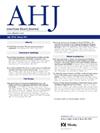Relationship between industry payments to physicians and prescription patterns for PCSK9is, ARNis and DOACs: A report from the NCDR PINNACLE registry
IF 3.5
2区 医学
Q1 CARDIAC & CARDIOVASCULAR SYSTEMS
引用次数: 0
Abstract
Background
We examined the association of industry payments to physicians and prescriptions for proprotein convertase subtilisin/kexin type 9 (PCSK9) inhibitors, angiotensin receptor-neprilysin inhibitor (ARNi), and direct oral anticoagulants (DOAC).
Methods
Using 2017 data from the NCDR PINNACLE Registry, we idenitifed 3 patient cohorts: those with atherosclerotic cardiovascular disease (ASCVD) and/or dyslipidemia, heart failure with reduced ejection fraction (HFrEF), and nonvalvular atrial fibrillation (NVAF). We linked physicians to the 2017 Open Payments data using National Provider Identifiers to determine whether they had received industry payments related to PCSK9 inhibitors, ARNi, or DOACs. The primary outcome of the study was the proportion of patients within each cohort who were prescribed the corresponding medication. Within each cohort, we evaluated the association between the receipt of industry payments by the treating physician (<$100, $100-$1,000, >$1,000) and likelihood of prescribing the corresponding medication using regression analyses.
Results
Overall, 0.2% of ASCVD patients were prescribed PCSK9 inhibitors, 9.0% of HFrEF patients were prescribed ARNi, and 38.7% of NVAF patients were prescribed DOACs. Patients whose physicians receiveds payments related to PCSK inhibitors were more likely to be prescribed them (ASCVD cohort: odds ratio [OR] 1.35; 95% confidence interval [CI],1.15-1.57), as were patients in the HFrEF cohort prescribed ARNi (OR 1.43; 95% CI, 1.19-1.71). No significant association was observed for DOAC prescribing (OR 0.99; 95% CI, 0.95-1.03). Across all 3 cohorts, physicians who received higher-value payments were more likely to prescribe the corresponding medications than those who received lower-value payments.
Conclusions
Patients with ASCVD or HFrEF whose physicians received industry payments were more likely to be prescribed PCSK9 inhibitors or ARNi, regardless of the payment amount. For DOACs, an association with prescribing was observed only among physicians who received higher-value payments.
行业对医生的支付与pcsk9、ARNis和DOACs处方模式的关系:一份来自NCDR PINNACLE注册中心的报告。
背景:我们研究了行业支付给医生的费用与蛋白转化酶枯草杆菌素/克心蛋白9型(PCSK9)抑制剂、血管紧张素受体-耐普利素抑制剂(ARNi)和直接口服抗凝剂(DOAC)处方的关系。方法:使用2017年NCDR PINNACLE Registry的数据,我们确定了三个患者队列:动脉粥样硬化性心血管疾病(ASCVD)和/或血脂异常、心力衰竭伴射血分数降低(HFrEF)和非瓣膜性心房颤动(NVAF)患者。我们使用国家供应商标识符将医生与2017年开放支付数据联系起来,以确定他们是否收到了与PCSK9抑制剂、ARNi或doac相关的行业付款。研究的主要结果是每个队列中接受相应药物治疗的患者比例。在每个队列中,我们使用回归分析评估了治疗医生收到的行业付款(1000美元)与开具相应药物的可能性之间的关系。结果:总体而言,0.2%的ASCVD患者使用了PCSK9抑制剂,9.0%的HFrEF患者使用了ARNi, 38.7%的NVAF患者使用了doac。医生收到与PCSK抑制剂相关的报酬的患者更有可能开PCSK抑制剂(ASCVD队列:优势比[OR] 1.35;95%可信区间[CI],1.15-1.57), HFrEF队列中服用ARNi的患者也是如此(OR 1.43;95% ci, 1.19-1.71)。DOAC处方无显著相关性(OR 0.99;95% ci, 0.95-1.03)。在所有三个队列中,获得较高报酬的医生比获得较低报酬的医生更有可能开出相应的药物。结论:无论支付金额如何,ASCVD或HFrEF的医生接受行业付款的患者更有可能开PCSK9抑制剂或ARNi。对于doac来说,只在获得高额报酬的医生中观察到与处方的关联。
本文章由计算机程序翻译,如有差异,请以英文原文为准。
求助全文
约1分钟内获得全文
求助全文
来源期刊

American heart journal
医学-心血管系统
CiteScore
8.20
自引率
2.10%
发文量
214
审稿时长
38 days
期刊介绍:
The American Heart Journal will consider for publication suitable articles on topics pertaining to the broad discipline of cardiovascular disease. Our goal is to provide the reader primary investigation, scholarly review, and opinion concerning the practice of cardiovascular medicine. We especially encourage submission of 3 types of reports that are not frequently seen in cardiovascular journals: negative clinical studies, reports on study designs, and studies involving the organization of medical care. The Journal does not accept individual case reports or original articles involving bench laboratory or animal research.
 求助内容:
求助内容: 应助结果提醒方式:
应助结果提醒方式:


